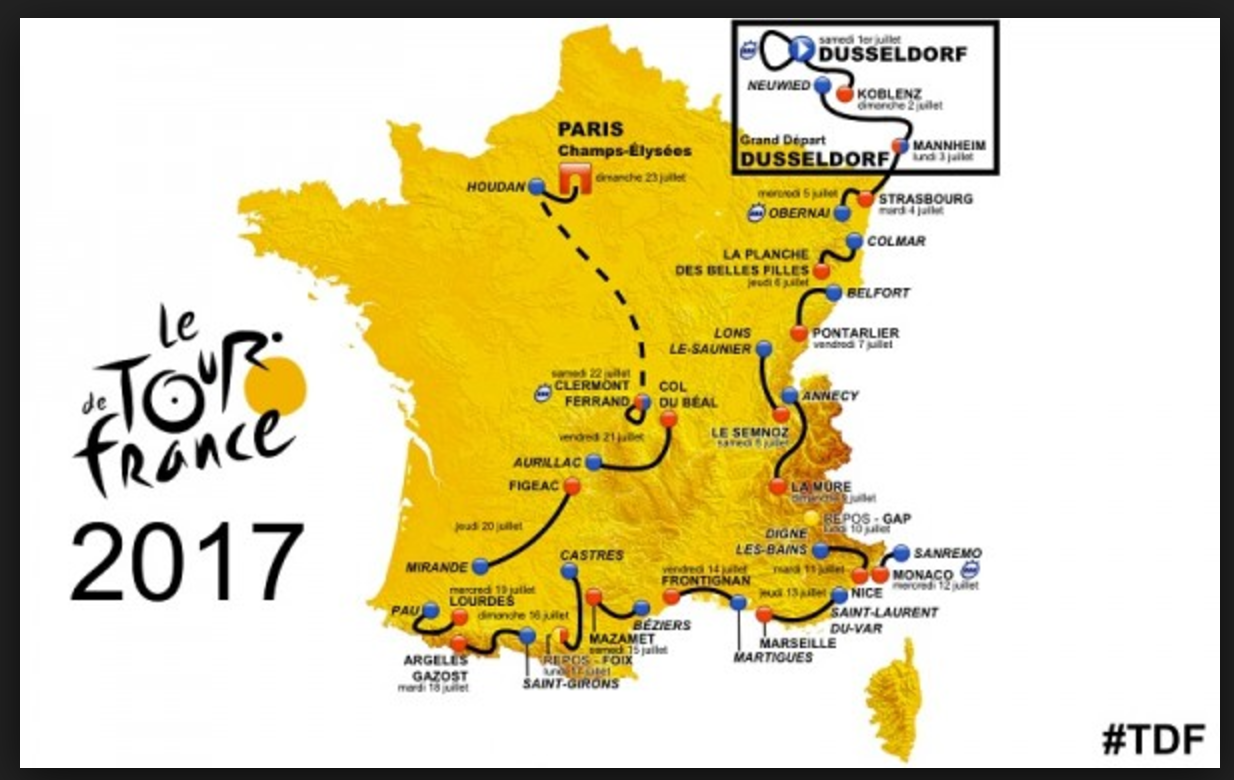
Why the Tour de France is Tops
Plus, Our Overall Jersey Picks
Oh sweet July – the month of warm air, cookouts, and the best sporting event in all the land. I proudly proclaim The Tour de France to be the most entertaining, physically demanding, and visually stunning televised sporting event in the world. Here’s why:
First, the facts.
The Tour de France is comprised of 21 stages of racing from July 1st to July 23rd. Some stages are flat; two are time trials, many involve mountains (and we’re not talking the Welsh Mountain here, we’re talking the Pyrenees and the Alps). Distances ridden range from 101 kilometers to 222 kilometers (with the two time trials at 14k and 22K). Racers must complete each stage within a certain percentage of time behind the winner or their tour is over. There’s no calling in sick. It’s not uncommon to see a rider struggling to complete a stage while suffering though a fever or stomach virus.
There are several races within the race. The general classification riders are trying to complete the entire 21 stages in the least amount of time. Throughout the race, the rider leading in this competition wears the yellow jersey. There are also segments and stages where points are awarded to the rider who is the best sprinter. The leader in this competition is awarded the green jersey. Same goes for the mountains. The leading points accumulator in climbing wears the famed polka dot jersey. Then there’s the working class of racing. These guys aren’t riding for personal glory. Chances are they’ll never stand on the podium in a special jersey of any color. Rather, they ride to pace and protect their team leaders.
Now to the meat of my argument.
There’s no bench in cycling. Don’t get me wrong, I admire athletes of all kinds, but if you’re a running back, you get to rest when the defense comes on the field. In baseball, you’re chillin’ in the dugout when you’re not on base or at bat. You can get called on and off the soccer field and the basketball court. Not so in cycling. I’m sure Mark Cavendish, a skilled sprinter who doesn’t vie for the overall yellow jersey win, would love to take a seat on the bus during the penultimate climb up the Alps. Not an option. Instead we watch him fight tooth and nail to climb the mountain and finish before the time cutoff. We see his greatness on flat sprinter stages, but then we see his weakness on mountain stages. What other sport shows you a multidimensional hero, one that goes from super human to a mere man in unrelenting pain?
So. Much. Strategy. This is why I watch every stage in its entirety. The last 30 kilometers can never encapsulate an entire race. Part of the thrill is watching a rider attempt an early breakaway (pulling away from the main group or peloton). That rider (or group of riders) has to hope he doesn’t burn too many matches getting away from the group and that he can sustain the gap he’s created until the finish. The peloton, on the other hand, has to decide if the rider breaking away is worth letting go. And if they do let him go, they have to make sure they start attacking in time to catch him. So many races come down to the breakaway riders getting caught within 5 or less kilometers of the finish. How heart wrenching is that?
Put simply, cycling ain’t for dummies. A rider always has to be conscious of not only his own race, but the race of every rider around him. His strategy is a living thing. It changes and evolves as the race itself takes form, and it requires cooperation with competitors on opposing teams. Breakaways and attacks call for riders to work together. Even if they’re rivals. They take turns leading the paceline. They do the work. Then, eventually, the cooperation ends and they battle it out for a win. There’s nothing like seeing riders yelling at each other as they establish a routine (on a local note, I’ve also heard Mark Branle yell, “You call yourself a bike racer?” during the PA State Championships. Turns out guys weren’t willing to work on that particular day). Point is, so much more than fast goes into winning a grand tour, or a state championship.
So. Much. Risk. I’m gonna get super blunt here, so excuse me, but you gotta have balls to be a bike racer (and I mean metaphorical balls here. Girls can have them, too). Elite riders are at risk of a catastrophic wreck every time they throw their leg over a bike. Having seen devastating wrecks in person, I understand the very real consequences and hate to see riders go down. So I’m not someone who celebrates carnage, but what I do admire is heart. In 2015, American Andrew Talansky suffered multiple wrecks in the beginning stages of the tour. The poor kid was riding with no skin on his back or hips. He was fighting fever from infection, but he didn’t get off his bike. He kept fighting to finish one of the hardest mountain stages of the tour. That kind of heart, that kind of refusal to give into pain or fear, that kind of day-in, day-out suffering is only seen in the tour. He didn’t finish that year, but man did he gain respect from other riders and fans the world over.
Now, also on the subject of risk, I will say that I think the UCI needs to step up and better protect riders. Like if a guy clearly has a concussion, let’s not let him get back on the bike. Or, the motos. Can we replace them with drones? Seems to me that motorcycles have hit one too many riders recently and I gotta imagine we can get great race footage in a safer way.
So. Much. Beauty. When the camera pans away from the riders and you catch a glimpse of the glittering Mediterranean, or primitive castle ruins, or cobblestone streets surrounded by rolling farmland…wow. It’s breathtaking really. Stunning. And, on a side note, the guys aren’t too bad looking, either. Amiright ladies? Whew.
In Conclusion, it seems to me cycling, the Tour de France in particular, takes the best attributes of all sports and combines them in a way that’s unequalled in any other event. The strength and brute force required in football, the refined skill (bike handling is no joke) required in baseball and soccer, the endless endurance of basketball (without commercial breaks and bench time), the nail biting risk of car racing, and heck, even the strategy of chess – The Tour has them all. Add to that the race etiquette that riders are expected to follow, the history, the setting…this is amazing stuff. The best. I rest my case.
Bikeworks 2017 TDF Picks:
ROB
Yellow Jersey: Nairo Quintana
Green Jersey: Peter Sagan
Polka Dot Jersey: Thibaut Pinot
BEN
Yellow Jersey: Chris Froome
Green Jersey: Peter Sagan
Polka Dot Jersey: Rafal Majka
AL
Yellow Jersey: Nairo Quintana
Green Jersey: Marcel Kittel
Polka Dot Jersey: Tom Dumoulin
REBECCA
Yellow Jersey: Richie Porte
Green Jersey: Greg Van Avermaet
Polka Dot Jersey: Romain Bardet
MARK
Yellow Jersey: Richie Porte
Green Jersey: Peter Sagan
Polka Dot Jersey: Thomas De Ghendt

